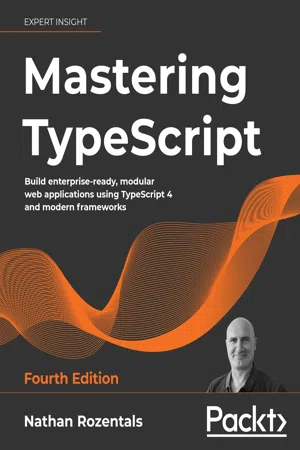
Mastering TypeScript
Build enterprise-ready, modular web applications using TypeScript 4 and modern frameworks, 4th Edition
- 538 pages
- English
- ePUB (mobile friendly)
- Available on iOS & Android
Mastering TypeScript
Build enterprise-ready, modular web applications using TypeScript 4 and modern frameworks, 4th Edition
About this book
Learn all you need to know to work with TypeScript, explore modern web application frameworks, and build modular systems using industry standard architectural principles and design patterns
Key Features
- Explore TypeScript 4's key elements and advanced language features
- Use TypeScript with modern frameworks such as Angular, Vue, React, RxJS and Node
- Understand TDD, serverless techniques, micro frontends, and other industry-standard best practices to create high-quality and modular apps
Book Description
TypeScript is both a language and a set of tools to generate JavaScript, designed by Anders Hejlsberg at Microsoft to help developers write enterprise-scale JavaScript.
Mastering Typescript is a golden standard for budding and experienced developers. With a structured approach that will get you up and running with Typescript quickly, this book will introduce core concepts, then build on them to help you understand (and apply) the more advanced language features. You'll learn by doing while acquiring the best programming practices along the way.
This fourth edition also covers a variety of modern JavaScript and TypeScript frameworks, comparing their strengths and weaknesses. You'll explore Angular, React, Vue, RxJs, Express, NodeJS, and others. You'll get up to speed with unit and integration testing, data transformation, serverless technologies, and asynchronous programming. Next, you'll learn how to integrate with existing JavaScript libraries, control your compiler options, and use decorators and generics.
By the end of the book, you will have built a comprehensive set of web applications, having integrated them into a single cohesive website using micro front-end techniques. This book is about learning the language, understanding when to apply its features, and selecting the framework that fits your real-world project perfectly.
What you will learn
- Gain insights into core and advanced TypeScript language features
- Integrate with existing JavaScript libraries and third-party frameworks
- Build full working applications using JavaScript frameworks, such as Angular, React, Vue, and more
- Create test suites for your application with Jest and Selenium
- Apply industry-standard design patterns to build modular code
- Develop web server solutions using NodeJS and Express
- Design and implement serverless API solutions
- Explore micro front-end technologies and techniques
Who this book is for
If you are keen to learn TypeScript, this book will give you all the necessary knowledge and skills to tackle any TypeScript project. It will also give you an understanding of what application frameworks are out there, and which one to choose for your next project. If you are already an experienced JS or TypeScript developer, then this book will take your skills to the next level. No JS experience is required to get started — we'll teach you all you need to know.
Frequently asked questions
- Essential is ideal for learners and professionals who enjoy exploring a wide range of subjects. Access the Essential Library with 800,000+ trusted titles and best-sellers across business, personal growth, and the humanities. Includes unlimited reading time and Standard Read Aloud voice.
- Complete: Perfect for advanced learners and researchers needing full, unrestricted access. Unlock 1.4M+ books across hundreds of subjects, including academic and specialized titles. The Complete Plan also includes advanced features like Premium Read Aloud and Research Assistant.
Please note we cannot support devices running on iOS 13 and Android 7 or earlier. Learn more about using the app.
Information
16
Micro Front-ends
- Micro front-end design concepts:
- How do we build a micro front-end?
- How do front-ends communicate with each other?
- Domain events
- An Event Bus
- Building a micro front-end application:
- A global Event Bus
- React updates
- Vue updates
- An Angular micro front-end
- Micro front-end summary
Design concepts
Table of contents
- Preface
- Up and Running Quickly
- Exploring the Type System
- Interfaces, Classes, Inheritance, and Modules
- Generics and Advanced Type Inference
- Asynchronous Language Features
- Decorators
- Integration with JavaScript
- Strict Compiler Options
- Using Observables to Transform Data
- Test-Driven Development
- Angular
- React
- Vue
- Node and Express
- An AWS Serverless API
- Micro Front-ends
- Other Books You May Enjoy
- Index